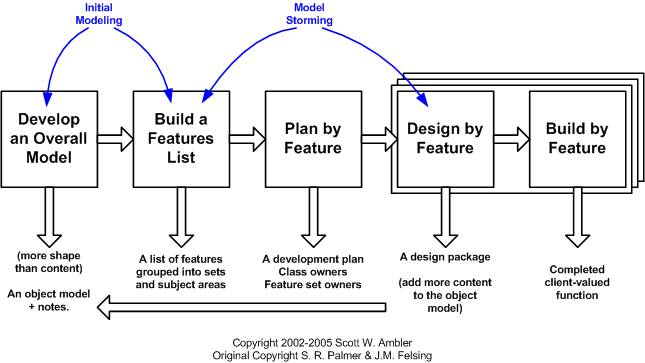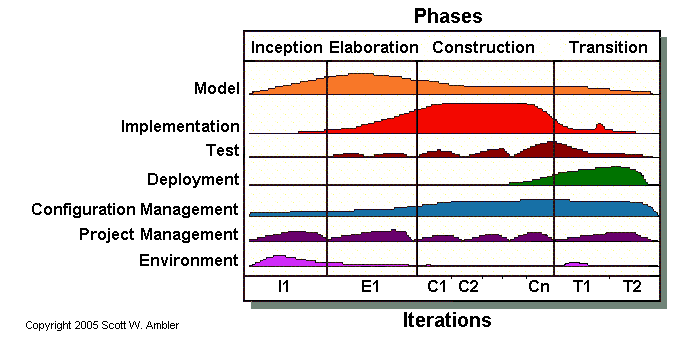CSC/ECE 517 Fall 2009/wiki3 11 HJ3: Difference between revisions
| Line 114: | Line 114: | ||
=== Overview === | === Overview === | ||
Feature Driven Development (FDD) | Feature Driven Development (FDD) [http://en.wikipedia.org/wiki/Feature_Driven_Development]i s an iterative and incremental software development process and is part of the Agile Alliance[http://en.wikipedia.org/wiki/Agile_Alliance#History]. FDD main purpose is to deliver tangible, working software repeatedly in a timely manner. | ||
FDD is a model-driven short-iteration process that consists of five basic activities. | FDD is a model-driven short-iteration process that consists of five basic activities. | ||
[[Image:LifecycleFDD.gif|The Lifecycle of a FDD]] | |||
| Line 136: | Line 133: | ||
=== Differences from XP === | === Differences from XP === | ||
FDD is identified as a process, whereas XP is more a set of principles. | |||
XP formalizes the requirement you write the test first, whereas FDD has little to say on the subject of testing and certainly does not mandate writing the tests first. | |||
== Lean Software Development (LSD) == | == Lean Software Development (LSD) == | ||
Revision as of 01:51, 24 November 2009
OTHER AGILE METHODS
Introduction
Agile software development is a software development methodologies based on iterative development throughout the life-cycle of the project. Simply put, Agile allows your team to identify the most critical features of the software that can be completed within a short time frame (normally 1 to 2 months), and it delivers a complete build with this set of limited features as the first iteration. Once that is done, you can move those features to production or continue on to the next iteration. By breaking the releases into shorter stints, it allows you to gain quicker releases and to capture return on investment more quickly by putting the working (but limited) features into production sooner. This is in stark contrast to the more traditional "Waterfall" approach, where you design all features upfront, code each one, test each one, then move into production. Agile projects are iteratively released to production months where Waterfall projects normally span a year or more before they are released to production. Agile software development refers to a group of software development methodologies based on iterative development, where requirements and solutions evolve through collaboration between self-organizing cross-functional teams. The term was coined in the year 2001 when the Agile Manifesto was formulated.
Agile methods generally promote a disciplined project management process that encourages frequent inspection and adaptation, a leadership philosophy that encourages teamwork, self-organization and accountability, a set of engineering best practices that allow for rapid delivery of high-quality software, and a business approach that aligns development with customer needs and company goals. Conceptual foundations of this framework are found in modern approaches to operations management and analysis, such as lean manufacturing, soft systems methodology, speech act theory (network of conversations approach), and Six Sigma.
Extreme Programming (XP)
Overview
XP (eXtreme Programming) is a more radical agile methodology, focusing on the software development process and addressing the analysis, development and test phases with novel approaches aimed at making a substantial difference to the quality of the end product.
Adaptive Software Development (ASD)
Overview
Adaptive Software Development is a software development process that grew out of rapid application development work which embodies the principle that continuous adaptation of the process to the work at hand is the normal state of affairs.
ASD replaces the traditional waterfall cycle with a repeating series of speculate, collaborate, and learn cycles. This dynamic cycle provides for continuous learning and adaptation to the emergent state of the project. The characteristics of an ASD life cycle are that it is mission focused, feature based, iterative, timeboxed, risk driven, and change tolerant.
The word “speculate” refers to the paradox of planning – it is more likely to assume that all stakeholders are comparably wrong for certain aspects of the project’s mission, while trying to define it. Collaboration refers to the efforts for balancing the work based on predictable parts of the environment (planning and guiding them) and adapting to the uncertain surrounding mix of changes caused by various factors – technology, requirements, stakeholders, software vendors, etc. The learning cycles, challenging all stakeholders, are based on the short iterations with design, build and testing. During these iterations the knowledge is gathered by making small mistakes based on false assumptions and correcting those mistakes, thus leading to greater experience and eventually mastery in the problem domain. [1]
Strength
Weakness
Differences from XP
Scrum
Overview
SCRUM is also an agile development method, which concentrates particularly on how to manage tasks within a team-based development environment.
Strength
Weakness
Differences from XP
Dynamic Systems Development Method (DSDM)
Overview
DSDM is probably the most complete agile methodology, whereas SCRUM and XP are easier to implement and complementary because they tackle different aspects of development projects and are both founded on the same principles of agile development. DSDM is probably the original agile development method. DSDM was around before the term 'Agile' was even invented, but is absolutely based on all the principles we’ve come to know as agile development.
Strength
Weakness
Differences from XP
Crystal
Overview
Crystal Clear is an agile methodology for projects with small teams, less than about 10 people in size. His focus is on the people, interaction, community, skills, talents, and communications with the belief that these are what have the first-order effect on performance. Process, he says, is important, but secondary.
Strength
Weakness
Differences from XP
Feature Drive Development (FDD)
Overview
Feature Driven Development (FDD) [1]i s an iterative and incremental software development process and is part of the Agile Alliance[2]. FDD main purpose is to deliver tangible, working software repeatedly in a timely manner. FDD is a model-driven short-iteration process that consists of five basic activities.
Strength
Weakness
Differences from XP
FDD is identified as a process, whereas XP is more a set of principles. XP formalizes the requirement you write the test first, whereas FDD has little to say on the subject of testing and certainly does not mandate writing the tests first.
Lean Software Development (LSD)
Overview
Lean software development is a translation of lean manufacturing principles and practices to the software development domain which is adapted from the Toyota Production System, where a pro-lean subculture is emerging from within the Agile community. Basically the lean manufacturing principles can also be applied to the software development process to resolve the issues.
Strength
- obtain better results
- improve the process
- eliminate waste
- decide as late as possible
- deliver as fast as possible
Weakness
- assumption that customer requirements are static and can be defined by a predetermined system
Differences from XP
XP is just the beginning. AUP goes at the cross team, enterprise level.
Agile Modeling (AM)
Overview
Agile Modeling (AM) is a collection of values, principles, and practices for effective modeling of software-based syastems that can be applied on a software development project in an effective and light-weight manner.
Strength
- can be applied on a software development project in a more flexible manner than traditional modeling methods
- provides advice for how to be effective as a modeler
- focus is on effective modeling and documentation
Weakness
- does not define detailed procedures for how to create a given type of model
- is not a complete software process
- doesn’t include programming and testing activities
- difficult to apply where there are large teams
Differences from XP
Because AM’s focus in on a portion of the overall software process you need to use it with another, full-fledged process such as XP.
For XP projects, AM explicitly describes how to improve productivity through addition of modeling activities.
Agile Unified Process (AUP)
Overview
Agile Unified Process (AUP), who is a simplified version of the IBM Rational Unified Process (RUP) [3], describes a simple, easy to understand approach to developing business application software using agile techniques and concepts yet still remaining true to the RUP. The AUP applies agile techniques including test driven development (TDD)[4], Agile Modeling [5], agile change management, and database refactoring [6] to improve productivity.
Strength
- ultra-lightweight variant of the Unified Process
- can apply to a very wide range of projects
- is adapted to the requirements of each individual projects
- applies agile techniques to improve productivity
- large number of artifacts
Weakness
- perceived as complicated
- more heavy than XP
Differences from XP
AUP framework [7] is often perceived as the anti-thesis of agility as practiced within XP. AUP uses agile variants of the same basic practices and project phases as RUP, with the work disciplines and work products simplified and reduced in number. XProgrammers will likely find the AUP fairly heavy, and "traditional RUP" users may find that it's too streamlined. XP is used when Programmers need something lighter. AUP is used when Progrmmers want a detailed, well-defined software process.
References
XP
[1] http://www.extremeprogramming.org/
[2] http://en.wikipedia.org/wiki/Extreme_Programming
[4] http://xprogramming.com/index.php
ASD
[5] http://en.wikipedia.org/wiki/Adaptive_Software_Development
[6] http://norvig.com/adapaper-pcai.html
[7] http://dirkriehle.com/computer-science/research/2000/xp-2000.pdf
[8] http://www.softwareplanner.com/SE_SP_adaptive_software_mkt.asp
Scrum
[9] http://en.wikipedia.org/wiki/Scrum_%28development%29
[10] http://softwareplanner.com/Newsletters/newsletter_2008_02_SP.htm
[11] http://scrummethodology.com/
[12] http://www.agile-software-development.com/2008/04/extreme-programming-versus-scrum.html
DSDM
[13] http://en.wikipedia.org/wiki/Dynamic_Systems_Development_Method
[14] http://www.ifi.uzh.ch/req/courses/seminar_ws03/14_Voigt_DSMD_Ausarbeitung.pdf
[15] http://www.freetutes.com/systemanalysis/sa2-dynamic-system-development-method.html
Crystal
[16] http://en.wikipedia.org/wiki/Crystal_Clear_%28software_development%29
[17] http://www.agilekiwi.com/crystal_clear.htm
FDD
[18] http://www.agilemodeling.com/essays/fdd.htm
[19] http://en.wikipedia.org/wiki/Feature_Driven_Development
[20] http://www.featuredrivendevelopment.com/node/519
LSD
[21] http://en.wikipedia.org/wiki/Lean_software_development
[22] http://www.poppendieck.com/
[23] http://www.projectperfect.com.au/downloads/Info/info_lean_development.pdf
[24] http://www.leansoftwareinstitute.com/art_ilsd.php
AM
[25] http://www.agilemodeling.com/essays/introductionToAM.htm
[26] http://en.wikipedia.org/wiki/Agile_Modeling
[27] http://www.ambysoft.com/books/agileModeling.html
[28] http://www.agilealliance.org/system/article/file/921/file.pdf
AUP
[29] http://www.ambysoft.com/unifiedprocess/agileUP.html
[30] http://en.wikipedia.org/wiki/Agile_Unified_Process
[31] http://en.allexperts.com/e/a/ag/agile_unified_process.htm

